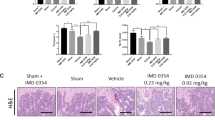Abstract
Remifentanil is commonly used in operating rooms and intensive care units for the purpose of anesthesia and sedation or analgesia. Although remifentanil may significantly affect the bone regeneration process in patients, there have been few studies to date on the effects of remifentanil on bone physiology. The purpose of this study was to investigate the effects of remifentanil on osteoclast differentiation and bone resorption. Bone marrow-derived macrophages (BMMs) were cultured for 4 days in remifentanil concentrations ranging from 0 to 100 ng/ml, macrophage colony-stimulating factor (M-CSF) alone, or in osteoclastogenic medium to induce the production of mature osteoclasts. To determine the degree of osteoclast maturity, tartrate-resistant acid phosphatase (TRAP) staining was performed. RT-PCR and western blotting analyses were used to determine the effect of remifentanil on the signaling pathways involved in osteoclast differentiation and maturation. Bone resorption and migration of BMMs were analyzed to determine the osteoclastic activity. Remifentanil reduced the number and size of osteoclasts and the formation of TRAP-positive multinuclear osteoclasts in a dose-dependent manner. Expression of c-Fos and NFATC1 was most strongly decreased in the presence of RANKL and remifentanil, and the activity of ERK was also inhibited by remifentanil. In the bone resorption assay, remifentanil reduced bone resorption and did not significantly affect cell migration. This study shows that remifentanil inhibits the differentiation and maturation of osteoclasts and reduces bone resorption.






Similar content being viewed by others
References
Elliott P, O’Hare R, Bill KM, Phillips AS, Gibson FM, Mirakhur RK. Severe cardiovascular depression with remifentanil. Anesth Analg. 2000;91:58–61.
Ouattara A, Boccara G, Kockler U, Lecomte P, Leprince P, Leger P, et al. Remifentanil induces systemic arterial vasodilation in humans with a total artificial heart. Anesthesiology. 2004;100:602–7.
Walsh MC, Kim N, Kadono Y, Rho J, Lee SY, Lorenzo J, et al. Osteoimmunology: interplay between the immune system and bone metabolism. Annu Rev Immunol. 2006;24:33–63.
Nakashima T, Takayanagi H. Osteoimmunology: crosstalk between the immune and bone systems. J Clin Immunol. 2009;29:555–67.
Kular J, Tickner J, Chim SM, Xu J. An overview of the regulation of bone remodelling at the cellular level. Clin Biochem. 2012;45:863–73.
Freeman KT, Koewler NJ, Jimenez-Andrade JM, Buus RJ, Herrera MB, Martin CD, et al. A fracture pain model in the rat: adaptation of a closed femur fracture model to study skeletal pain. Anesthesiology. 2008;108:473–83.
Aro HT, Wippermann BW, Hodgson SF, Chao EY. Internal remodeling of periosteal new bone during fracture healing. J Orthop Res. 1990;8:238–46.
Cruess RL, Dumont J. Fracture healing. Can J Surg. 1975;18:403–13.
Boyle WJ, Simonet WS, Lacey DL. Osteoclast differentiation and activation. Nature. 2003;423:337–42.
Wada T, Nakashima T, Hiroshi N, Penninger JM. RANKL-RANK signaling in osteoclastogenesis and bone disease. Trends Mol Med. 2006;12:17–25.
King T, Vardanyan A, Majuta L, Melemedjian O, Nagle R, Cress AE, et al. Morphine treatment accelerates sarcoma-induced bone pain, bone loss, and spontaneous fracture in a murine model of bone cancer. Pain. 2007;132:154–68.
Matziolis G, Rau HM, Klever P, Erli HJ, Paar O. Modification of human osteoblasts by various analgesics. Unfallchirurg. 2002;105:527–31.
Lacey DL, Timms E, Tan HL, Kelley MJ, Dunstan CR, Burgess T, et al. Osteoprotegerin ligand is a cytokine that regulates osteoclast differentiation and activation. Cell. 1998;93:165–76.
Rao A, Luo C, Hogan PG. Transcription factors of the NFAT family: regulation and function. Annu Rev Immunol. 1997;15:707–47.
Takayanagi H, Kim S, Koga T, Nishina H, Isshiki M, Yoshida H, et al. Induction and activation of the transcription factor NFATc1 (NFAT2) integrate RANKL signaling in terminal differentiation of osteoclasts. Dev Cell. 2002;3:889–901.
Zhao Q, Wang X, Liu Y, He A, Jia R. NFATc1: functions in osteoclasts. Int J Biochem Cell Biol. 2010;42:576–9.
Choi HJ, Park YR, Nepal M, Choi BY, Cho NP, Choi SH, et al. Inhibition of osteoclastogenic differentiation by Ikarisoside A in RAW 264.7 cells via JNK and NF-kappaB signaling pathways. Eur J Pharmacol. 2010;636:28–35.
Lee ZH, Kim HH. Signal transduction by receptor activator of nuclear factor kappa B in osteoclasts. Biochem Biophys Res Commun. 2003;305:211–4.
Huang H, Chang EJ, Ryu J, Lee ZH, Lee Y, Kim HH. Induction of c-Fos and NFATc1 during RANKL-stimulated osteoclast differentiation is mediated by the p38 signaling pathway. Biochem Biophys Res Commun. 2006;351:99–105.
Huang H, Ryu J, Ha J, Chang EJ, Kim HJ, Kim HM, et al. Osteoclast differentiation requires TAK1 and MKK6 for NFATc1 induction and NF-kappaB transactivation by RANKL. Cell Death Differ. 2006;13:1879–91.
Ishii M, Saeki Y. Osteoclast cell fusion: mechanisms and molecules. Mod Rheumatol. 2008;18:220–7.
Pérez-Castrillón JL, Olmos JM, Gómez JJ, Barrallo A, Riancho JA, Perera L, et al. Expression of opioid receptors in osteoblast-like MG-63 cells, and effects of different opioid agonists on alkaline phosphatase and osteocalcin secretion by these cells. Neuroendocrinology. 2000;72:187–94.
Rosen H, Bar-Shavit Z. Dual role of osteoblasticproenkephalin derived peptides in skeletal tissues. J Cell Biochem. 1994;55:334–9.
Rico H, Costales C, Cabranes JA, Escudero M. Lower serum osteocalcin levels in pregnant drug users and their newborns at the time of delivery. Obstet Gynecol. 1990;75:998–1000.
Baik SW, Park BS, Kim YH, Kim YD, Kim CH, Yoon JY, et al. Effects of remifentanil preconditioning on osteoblasts under hypoxia-reoxygenation condition. Int J Med Sci. 2015;12:583–9.
Author information
Authors and Affiliations
Corresponding author
Ethics declarations
Conflict of interest
The authors have no financial conflicts of interest.
Ethical standard
Animal experiments were approved by the Committees on the Care and Use of Animals in Research at Pusan National University Dental Hospital (IACUC No. PNUDH-2016-032).
Rights and permissions
About this article
Cite this article
Yoon, JY., Baek, CW., Kim, HJ. et al. Remifentanil Negatively Regulates RANKL-Induced Osteoclast Differentiation and Bone Resorption by Inhibiting c-Fos/NFATc1 Expression. Tissue Eng Regen Med 15, 333–340 (2018). https://doi.org/10.1007/s13770-018-0116-z
Received:
Revised:
Accepted:
Published:
Issue Date:
DOI: https://doi.org/10.1007/s13770-018-0116-z




